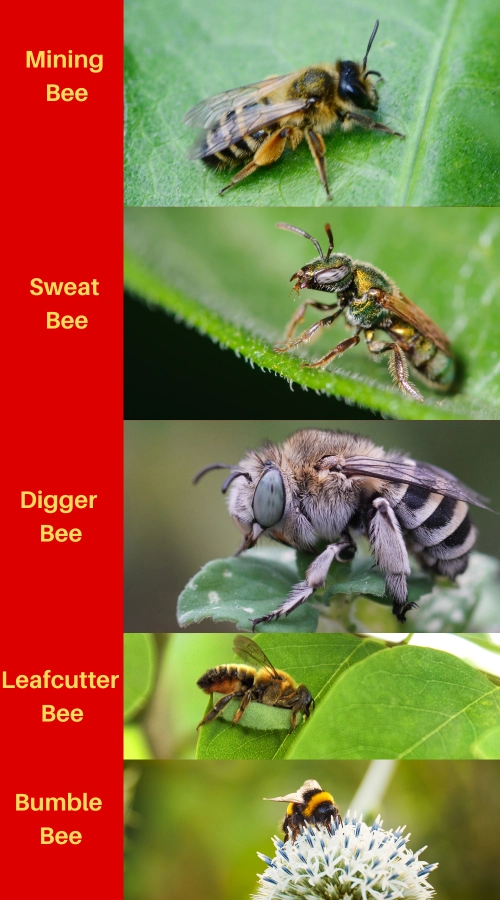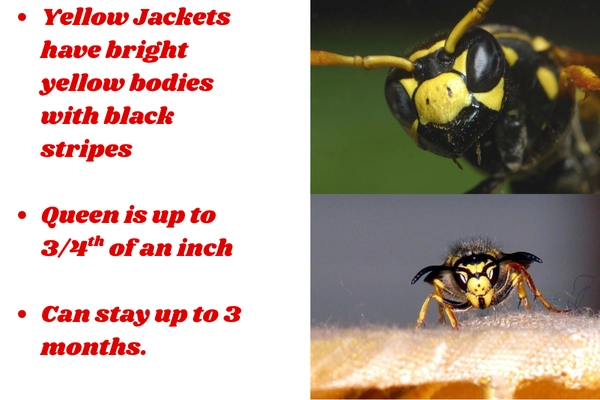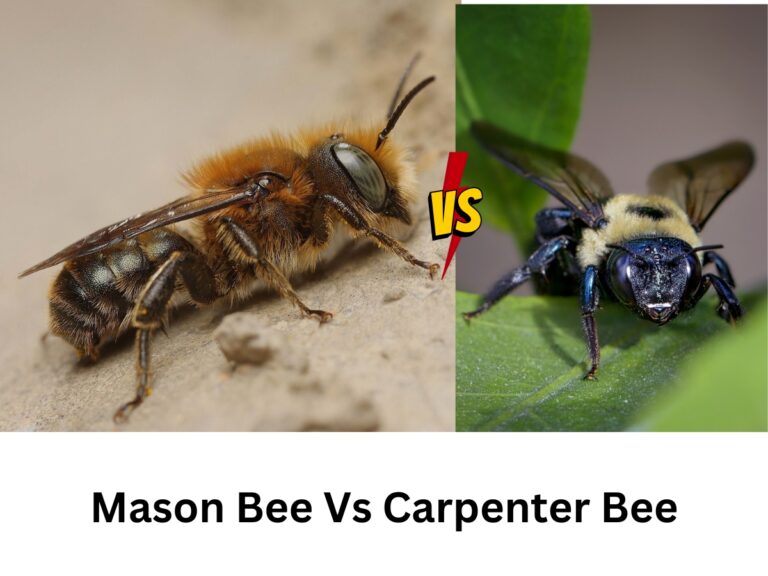This post might be created with help from AI tools and carefully reviewed by a human (Anthor Kumar Das). For more on how we use AI on this site, check out our Editorial Policy.
Ground Bees vs Yellow Jackets: Friend or Foe?
When you see flying insects around your yard or garden, it’s easy to mix up ground bees and yellow jackets. They look somewhat alike, and many people can’t tell which is which.
I remember the first time I saw them buzzing near my lawn. I wasn’t sure if they were harmless bees or aggressive yellow jackets. If you’ve ever felt that confusion, you’re not alone.
Even though they share a few similarities in appearance, ground bees and yellow jackets are very different. Their behavior, nesting habits, and even their roles in nature are not the same.
In this post, I’ll walk you through a clear and simple comparison of Ground Bees vs Yellow Jackets. By the end, you’ll know exactly how to tell them apart and how to stay safe around each.
What Is Ground Bees?
Ground bees are the type of bees that nest on the ground or near the ground. Due to their ground-nesting habit, they are named so.

Ground bees are usually less than 3/4th of an inch in size. They are different in size and color, including red, blue, black, yellow, and many more.
Most of the Ground bees are solitary in nature. They usually don’t live in a colony. They don’t have a queen or a democratic colony like honey bees.
However, some ground bees, such as bumble bees, also led colonial life.
They are usually seen in the early spring. They don’t stay in the same place for more than 8 weeks. In most cases, ground bees emerge in a new location or die out within 4 to 6 weeks.
Most of the ground bees also contribute to pollination. They are not too aggressive. Some female ground bees have the capability to sting their enemies repeatedly. But they use sting very rarely.
Different Types of Ground Bees
There are many species of ground bees living in our gardens and lawns. Each has its own look and behavior. Knowing the common ones can help you identify them easily.

1. Mining Bees (Andrena species)
These are one of the most common ground-nesting bees. They are small, fuzzy, and often seen digging little holes in the soil during spring. Mining bees are excellent pollinators and rarely sting.
2. Sweat Bees (Halictidae family)
Sweat bees get their name because they are attracted to human sweat. They are tiny and shiny, sometimes green or metallic in color. Even though they might land on you, they are not aggressive.
3. Digger Bees (Anthophora species)
Digger bees look quite similar to honey bees but nest in loose soil. You might find their burrows in dry, sandy areas. They are fast flyers and very active during warm sunny days.
4. Leafcutter Bees (Megachile species)
Leafcutter bees are also ground-nesting in some cases. They cut small circular pieces from leaves to build their nests. These bees are important for pollinating garden flowers and crops.
5. Bumble Bees (Bombus species)
Some bumble bees also choose to build nests near the ground, often in abandoned rodent burrows. They live in small colonies and are strong pollinators for many plants.
What Is Yellow Jackets?
Yellow jackets are a type of wasp known for their bright yellow bodies with black stripes. Some species can also be black and white. All female yellow jackets can sting more than once, which makes them quite defensive when disturbed.

Yellow jackets are also social creatures like honey bees. They live in a colony having workers, queens, and drones.
Their queen is up to 3/4th of an inch in length, and workers are usually up to half an inch.
The queen in early winter emerges to build a nest in a suitable nest site where she lays eggs.
Their common nesting sites include trees, High mounds, logs, hollow woods, sometimes inside human houses, and similar other locations.
She lays eggs and raises broods on her own. When small worker bees are raised, a new colony is built.
After that, worker bees take care of all the future larvae and pupae. Every late spring, Queen Yellow Jackets left the old colony to build a new colony.
Yellow jackets usually stay 2 to 8 weeks in a single colony. They can stay up to 3 months in a single location.
Mostly seen in the early spring when ground bees also start to appear. Because in early spring, the larvae come up from eggs laid during winter by the queen.
They have very strong mandibles. Using the small mandibles, yellow jackets can eat the following.
- Small insects like ants
- Nectar
- Fruit juices
- Tree sap, etc.
Sometimes people become confused between yellow jackets and honey bees. As they possess some similar looks and appear at the same time of the year.
Why Are Yellow Jackets So Aggressive?
Unlike ground bees, yellow jackets are fully social insects. They live in colonies where hundreds of workers protect their queen and larvae. This strong urge of defense makes them naturally more aggressive.
When they sense any danger near their nest, they see it as a threat. Even small movements or vibrations can make them attack.
Once alarmed, they may sting repeatedly and even chase the intruder for several feet.
Their aggressive behavior comes from their instinct to guard their home. That’s why it’s always best to stay calm and avoid disturbing areas where yellow jackets nest.
If you see one nearby, slowly move away instead of waving your hands or running suddenly.
Comparison Of Ground Bees VS Yellow Jackets
There are a lot of differences and similarities between ground bees and yellow jackets.

A comparison between these 2 creatures is shown in the following table.
| Characteristics | Ground Bee | Yellow Jackets |
| Size | Less than 0.75 Inches. Usually around 0.5 inches. | The queen size is up to 0.75 inches. Worker size is less than 0.5 inches. |
| Pollen basket | Ground Bees Have Pollen Basket. | Yellow jackets don’t have any pollen baskets. |
| Pollination | Most of the ground bees are pollinators. There are some non-pollinating ground bees too. | Yellow jackets are less likely to pollinate in nature as they don’t have pollen baskets. |
| Instinct | Most of the ground bees are solitary in nature. | All yellow jackets are social in nature. |
| Nest site | Mainly live in the ground. Some of the ground bees also make nests in wood. | Create their nest in trees, soil cavities, house walls, and other protective locations. |
| Body Color | Black, yellow, red, or blue body color. | Black and yellow bodies. Sometimes white and black bodies. |
| Body hair | They have dense hairy bodies. | They have very little dense body hair. |
| Food habit | Used to eat ground-living small insects, pollen, tree sap, etc. | They eat small ground living or flying insects, fruits, flower nectar, etc. |
| Aggressiveness | Ground bees are very less aggressive. Female ground bees can rarely sting. | Yellow jackets are very aggressive. They sting their enemy multiple times at once. |
| Life span | Usually 4 to 6 weeks. | Usually 2 to 3 weeks. |
| Venom | Their sting is usually less poisonous. | Comparatively more poisonous stings. |
These are the most common characteristics of ground bees and yellow jackets.
But still, people get confused about identifying whether it is ground bees or yellow jackets.
Bee or Yellow Jacket? Here’s How to Know
You can easily tell whether the insect you see is a bee or a yellow jacket by watching its body, movement, and behavior. Just take a close look and follow these tips.
1. Look at the body.
If the insect has less hair and bright yellow with black or white stripes, it is most likely a yellow jacket. Bees usually have fuzzy bodies covered with more hair and come in shades of brown, black, or golden.
2. Watch how it reacts.
If it starts chasing you even when you did not disturb it, that’s a sign of a yellow jacket. Male ground bees may fly around you to scare you off, but they cannot sting.
3. Notice the sting behavior.
If you are stung multiple times, it’s surely a yellow jacket. Bees can sting only once and then die.
4. Check for pollen.
Bees carry pollen in small pollen baskets on their back legs. Yellow jackets never do this because they don’t collect pollen.
In short, bees are gentle pollinators, while yellow jackets are more aggressive protectors. If you spot one, stay calm and observe from a safe distance.
Frequently Asked Questions About Ground Bees VS Yellow Jackets
What is the most aggressive ground bee?
Among all of the ground bees, Africanized honey bees are the most aggressive ground-nesting bees. Their sting is very painful. But they can sting you only once and then die.
Do yellow jackets have venom?
Yes, yellow jackets have strong venom that causes too much pain after getting stung. Their venom can cause allergic reactions and blood infections too.
Are yellow jackets harmful?
If you can keep yourself far from yellow jackets they won't be harmful for you. But in case yellow jackets treat you as a threat it will sting you continuously. Their venom is very poisonous. If you are allergic to yellow jacket sting then it could be more worse for you.
Should I get rid of Ground bees?
Ground bees are not harmful. So, if it is not making any problem for you then you should not need to get rid of them. Usually, they will leave your place on their own within 4 to 6 weeks. They are also beneficial for our nature. So, try to leave them alone. It would be good for you and them.
Yellow Jackets VS Ground Bees: Which One Is Helpful?
Remember, every creature has benefits for our environment. Yellow jackets and ground bees also help to keep balance in our ecosystem.

Benefits Of Yellow Jackets
The following are the ecological benefits of yellow jackets.
- Predators: Yellow jackets help us to control pests and harmful insects by eating them. They can eat small insects like arthropods, ants, spiders, etc.
- Food source: For some other helpful animals, yellow jackets are a source of food. Birds, reptiles, frogs, and other animals might prey on yellow jackets for protein content.
- Pollination: Yellow jackets indirectly help in pollination while collecting nectar from different plants.
- Ecological Balancing: Eating pests, providing food sources to other animals, and eating waste like fallen fruits yellow jackets are contributing to ecological balancing.
Benefits Of Ground Bees
The following are the benefits of having ground bees for our nature.
- Pollination: Almost 80% of the bee species are ground-nesting. So, they contribute a huge portion to worldwide pollination.
- Seasonal Fruits: Some of the seasonal fruits, like strawberries, strongly depend on pollination by ground bees.
- Harmless: Male ground bees don’t have any stings, and female ground bees very rarely use their stings. This is why ground bees are often considered harmless.
- Provide Food Source to Predators: Ground nesting bees are rich in protein. This is why predator animals like woodpeckers, raccoons, bears, frogs, Reptiles, bats, and giant lizards prey on ground bees.
There are countless benefits of ground bees for nature. They are contributing a lot to the Earth’s ecosystem.
Both ground bees and yellow jackets play roles in our ecosystem.
But yellow jackets are more aggressive and often seen as pests.
Ground bees, on the other hand, are gentle pollinators that help flowers and crops grow.
So, while both are important, ground bees are definitely more beneficial and safer for our environment.
But don’t kill any of these helpful creatures. If they create nests inside your house, try safe methods to get rid of them. But don’t kill them.
If possible, provide a suitable nesting site far from your house. This will keep them away from the house, and they will benefit our nature as well.







